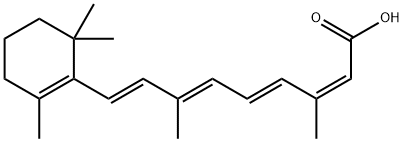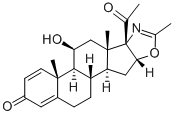
4759-48-2
- Product Name:Isotretinoin
- Molecular Formula:C20H28O2
- Purity:99%
- Molecular Weight:300.44
Product Details:
CasNo: 4759-48-2
Molecular Formula: C20H28O2
Appearance: Yellow-orange to orange Fine Crystalline Powder
Delivery Time: 2 weeks after order
Throughput: 100KG/Month
Purity: 99%
Synonyms: Tretinoin Impurity 1(Tretinoin EP Impurity A); Isotretinoin-D5/13-cis-Retinoic acid-D5; Roaccutan;(2Z,4E,6E,8E)-3,7-diMethyl-9-(2,6,6-triMethylcyclohex-1-en-1-yl)nona-2,4,6,8-tetraenoic acid
Melting point: 172-175 °C (lit.)
Boiling point: 381.66°C (rough estimate)
Density: 1.0597 (rough estimate)
Refractive index: 1.4800 (estimate)
Solubility: Practically insoluble in water, soluble in methylene chloride, slightly soluble in ethanol (96 per cent). It is sensitive to air, heat and light, especially in solution. Carry out all operations as rapidly as possible and avoid exposure to actinic light; use freshly prepared solutions.
Pka: 4.76±0.33
Biological source: synthetic
Water Solubility: insoluble
Stability: Stable, but probably air and light sensitive. Combustible. Incompatible with strong oxidizing agents.
Pharmacological effects: Isotretinoin belongs to the first generation of vitamin A acid. It is a stereoisomer of all-trans vitamin A acid. Oral administration has an anti-oil effect which has special effect on severe acne. The mechanism is as follows:
① it can reduce sebaceous gland and inhibit the activity of sebaceous gland, reducing the effect of secretion of the sebaceous glands, thus inhibiting the growth of Propionibacterium which relies on lipid environment.
② it has an anti-keratosis effect, can inhibit the excess proliferation of epidermal and promote its differentiation. It also reduces the keratosis of hair follicles and the catheter of sebaceous glands.
③ it can also affect the function of lymphocytes and monocytes, and inhibit the chemotaxis of neutrophil, and thus having anti-inflammatory activity.
④ it can exert its therapeutic effect by selectively binding Vitamin A acid nuclear receptors. It can inhibit the proliferation of acne rod bacilli. Moreover it has effects of immunity stimulation at low doses, but has immunity suppression effect at high doses.
⑤ It can inhibit the biogenesis of collagenase and gelatinase in the skin, and can also inhibit the activity of ornithine decarboxylase. Owing to the major role of ornithine decarboxylase in inducing skin mutations, so isotretinoin can also suppress tumorigenesis.
⑥ when subjects to topical administration, it has a similar mechanism of action as vitamin A acid which induces the proliferation of epidermal cell, promotes the differentiation of epidermal cell granular layer into the stratum corneum. It can also regulate the horny plug occurring during some abnormal cornification processes of Hair follicle sebaceous epithelium, and thus playing a therapeutic role.
Uses: Isotretinoin is a vitamin A class drugs that It can rapidly and strongly inhibit the cell proliferation and differentiation process of skin glands cells. It has a high effect on severe nodular cystic acne. This product has a high gastrointestinal absorption, but invalid for topical administration. It is used for treating severe acnes which cannot be treated by other drugs. It also has some effects on treating cystic acne, the party of acne, rosacea, ichthyosis, follicular keratosis and pityriasis red hair and other skin diseases.
Indications:
1. Isotretinoin should be the primary choice for treatment of refractory acne, especially for severe nodular, cystic, inflammatory acne patients to whom conventional therapy is ineffective.
2. Generalized Plana or verrucous epidermal dysplasia;
3. Skin disease of abnormal cornification;
4. Cutaneous lupus erythematosus;
5. lichen planus, atrophic lichen sclerosis.
Drug Interactions:
1. Combination with warfarin can enhance the latter one’s effect.
2. Combination together with Avi A ester, vitamin A acetate or Vitamin A acid can increase the incidence and severity of adverse reactions.
3. Combination with methotrexate can increase the blood concentration of the latter one, and thus increasing the damage to the liver.
4. Combination with tetracycline can lead to brain and cause pseudo-tumor in brain and cause benigh hypertension. Clinical manifestations of hypertension are accompanied by headache, dizziness and visual disturbances.
5. Combination with carbamazepine results in decreased plasma concentrations of the latter one.
6. Combination with light-sensitive drugs increases the light-sensitive effect.
Relevant Products
-
Decanoyl/octanoyl-glycerides
CAS:65381-09-1
-
DEFLAZACORT
CAS:13649-88-2
-
1-chloro-2-propyl-benzene
CAS:1730-86-5








